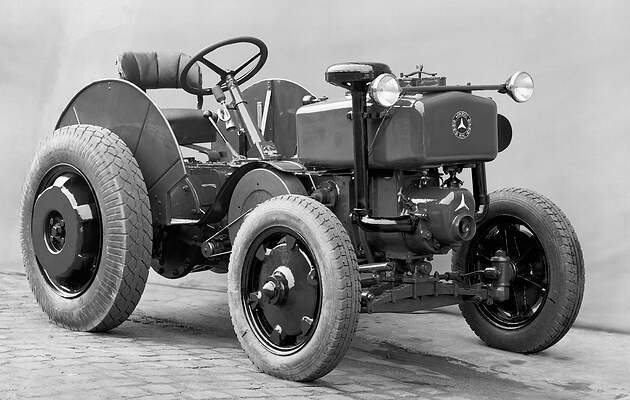The predecessor companies of Daimler-Benz AG both had many years of experience in building vehicles for the agricultural sector. Benz & Cie in particular was more than successful here with its Benz-Sendling motorised ploughs and tractors, so that the Benz-Sendling BK remained in the range even after the founding of Daimler-Benz AG. However, the development department was working flat out on a successor, which was to be produced in Untertürkheim by Daimler-Benz itself and no longer, like the Type BK, under contract by Komnick in Elbing.
This successor was launched at the beginning of 1928, when the OE was brought onto the market in a frameless block design. OE stood for "Oelmotor Einzylinder" (single-cylinder diesel engine), as the power source for this tractor is a horizontal pre-chamber diesel engine with one cylinder, which generates an output of around 24 hp (18 kW) from a displacement of 3433 cc. It was so robustly constructed that it could even tolerate poor fuel qualities without problems and could even be operated with heavy fuel oil. It had an evaporative cooling system and was started with an ignition cartridge using a hand crank. The transmission was a three-speed differential gearbox, with the single-plate dry clutch housed in the flywheel. Power was transmitted to the rear wheels directly from the transmission via spur gears. A hand brake acting on the rear wheels was available as a brake. The front axle on the OE was designed as a swing axle with rack-and-pinion steering and offered a choice of leaf or coil spring suspension.
The OE was available in two versions right from the start. As an agricultural tractor, it had iron wheels with angled grippers to make progress even on poor ground. As a road tractor, it is equipped with disc wheels with elastic tyres. In addition, two modified gearwheels were installed, which changed the transmission ratio. However, agricultural and road tractors could be converted from one to another in just a few simple steps.
In the course of 1929, Daimler-Benz technically revised the OE. The engine now had a displacement of 4241 cc, which increased the power output to 26 hp (19 kW). At the same time, recirculation cooling could now also be installed on request. In addition, the so-called combination tractor complemented the range. It was supplied with wheel and gear sets for agricultural and road tractors, so that customers could configure it themselves according to the desired application. A short time later, the road tractor could also be fitted with newly developed pneumatic tyres.
Although the OE was generally regarded as the best tractor of its time, production was discontinued in 1935 after only around 380 units had been manufactured. The lack of purchasing power of potential customers during the years of the global economic crisis was a major obstacle to commercial success. Daimler-Benz AG would not return to the agricultural vehicle market until after the Second World War with the Unimog and later the MBtrac.


